That persistent itch, the redness, the flaking skin… when you’re dealing with a fungal infection, all you want is relief. But with so many products and so much conflicting information, it’s hard to know where to start. You’ve likely asked yourself, “What is the best antifungal cream for me?” The answer isn’t just about the active ingredient; it’s about understanding the specific type of fungus you’re fighting and choosing a solution with the power to truly defeat it.
This comprehensive guide will walk you through the world of skin fungi, from the most common culprits to the most stubborn infections. We’ll show you how to identify your condition and, most importantly, provide a clear path to fast, effective relief with a solution that’s clinically proven to work.
A Quick Reference Guide to Common Skin Fungi
Fungal Infection | Affected Area | Key Symptoms | Common Cause | Can Terrasil help? |
|---|---|---|---|---|
Athlete’s Foot (tinea pedis) | Feet, between toes | Itching, peeling, burning | Walking barefoot in public areas | |
Ringworm (tinea corporis) | Body (not scalp, face, groin, feet) | Red, circular rash with raised edges | Skin-to-skin contact, contaminated surfaces | |
Jock Itch (tinea cruris) | Groin, inner thighs | Red, itchy, ring-shaped rash | Sweating, friction, tight clothing | |
Scalp Ringworm (tinea capitis) | Scalp, hair follicles | Scaling, patches of hair loss | Shared combs, hats, close contact | |
Nail Fungus (tinea unguium) | Nails (toes, fingers) | Thickened, discolored, brittle nails | Trapped moisture, persistent foot fungus | |
Facial Ringworm (tinea faciei) | Face | Red rash, small lesions, lack of “ring” | Direct contact | |
Beard Ringworm (tinea barbae) | Beard, mustache | Inflamed nodules, pustules | Contaminated razors | |
Tinea Versicolor (malassezia) | Trunk, neck, arms | Discolored patches of skin, flaking | Fungal overgrowth, hot/humid climates | |
Cutaneous Candidiasis (candida) | Skin folds (under breasts, groing) | Red, raw-looking rash, satellite lesions | Yeast overgrowth in moist areas | |
Bar Rot (Candida, Bacteria) | Skin around nails/cuticles | Redness, swelling, discomfort, inflammation | Chronic wetness, trauma to cuticles |
The Fungal Family Tree: Every Type Explained
Understanding the full spectrum of fungal skin infections empowers you to identify your specific condition and seek appropriate treatment. The different types of tinea are named for the area of the body they infect. The fungi responsible are typically dermatophytes, which are mold-like parasites that thrive on keratin, a protein found in your skin, hair, and nails [1, 2].
The word “tinea” is a Latin term for “gnawing worm.” Historically, people thought these itchy, ring-shaped rashes were caused by a worm burrowing under the skin. While we now know a worm isn’t the culprit, the name has stuck as the medical classification for these common dermatophyte infections [1].
Tinea Pedis (Athlete’s Foot)
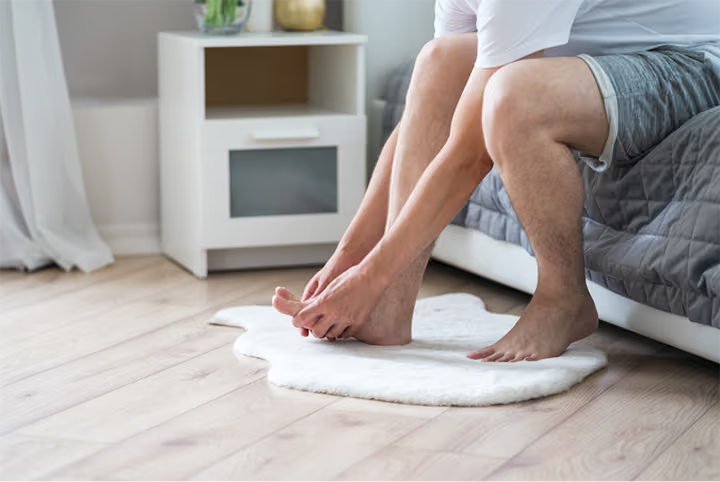
The champion of fungal infections—and not just for athletes! This stubborn condition affects up to 20% of the world’s population at some point and is more prevalent in developed countries [3]. It thrives in the warm, moist environment of enclosed feet.
- Key Symptoms: The defining symptom is intense itching, often described as a burning or stinging sensation [4]. This itching can be particularly bothersome when you take off your shoes and socks, as the fungus is exposed to air. Other symptoms include peeling, cracking skin between the toes, and in severe cases, painful blisters.
- How it Spreads: You can pick up athlete’s foot spores by walking barefoot on floors where the fungus is present, like locker rooms, swimming pools, and showers. From there, it can be spread to other parts of your body, like your hands (Tinea Manuum), or to other family members if hygiene isn’t maintained [4].
Tinea Corporis (Body Ringworm)
The “ring” that isn’t a worm. This infection got its name because it often creates a distinctive, circular rash with raised, scaly borders and a clear center. It can show up anywhere on your body and is highly contagious through direct contact with an infected person or animal, or contaminated surfaces like towels or clothing [5].
- Key Symptoms: The primary symptom is an itchy rash, which may be mild or quite bothersome [6]. The rash itself can be pink-to-red and have a scaly texture [4]. The classic “ring” is a key identifier.
- Diagnostic Tip: Tinea corporis can be confused with conditions like eczema or psoriasis [6]. The key differentiating feature is that well-defined, raised border with central clearing [2].
Tinea Cruris (Jock Itch)
Despite its nickname, this isn’t exclusive to male athletes. The infection loves the warm, moist environment of the groin area and can affect anyone who sweats and wears tight clothing. The primary culprit is often Trichophyton rubrum, which is also a common cause of athlete’s foot [7].
- Key Symptoms: This rash is notoriously itchy and may be painful [8]. The sensation can be worse with exercise or as the day goes on, and can feel like a stinging or burning sensation.
- Key Characteristics:
- Red, itchy, ring-shaped rash in groin folds [8].
- Typically spares the scrotum (a key difference from yeast infections).
- May extend to inner thighs and buttocks.
Tinea Capitis (Scalp Ringworm)
This infection is a common reason for a child’s school to send home a note about ringworm. It is the most common fungal infection in prepubertal children and can cause patches of hair loss [6]. Critical point: Unlike body ringworm, topical treatments are often ineffective for tinea capitis because the fungus is deep in the hair follicles. It typically requires an oral antifungal agent prescribed by a healthcare provider [2].
Tinea Manuum (Hand Ringworm)
Often overlooked, this infection typically affects one hand more than the other. It’s frequently seen in people who also have athlete’s foot (the “one hand, two feet” pattern).
- Key Symptoms: The rash on the hand is usually itchy and can cause dry, cracked palms and peeling skin [2].
Tinea Unguium (Nail Fungus/Onychomycosis)
This is the most stubborn and treatment-resistant of all tinea infections. It causes thickened, deformed, and discolored nails.
- Key Symptoms: Unlike other tinea infections, nail fungus typically does not cause itching. The main symptoms are changes to the nail’s appearance: thickening, crumbling, discoloration (yellow, brown, or white), and separation from the nail bed.
Tinea Versicolor (Pityriasis Versicolor)
This is the “leopard spot” infection. It’s caused by an overgrowth of Malassezia yeast, which is naturally present on the skin but can grow out of control in hot, humid climates. This fungus disrupts normal skin pigmentation, causing patches of skin to be either lighter or darker than your normal skin tone [9]. The rash is typically found on the trunk, neck, and arms.
- Key Symptoms: The patches may have a fine scale and may be slightly itchy, but they are often not symptomatic and are noticed more for their cosmetic appearance [9].
Cutaneous Candidiasis (Yeast Infection of the Skin)
Think of Candida as the fungus that loves skin folds—anywhere your skin touches skin and stays moist. It’s often found in armpits, under breasts, in the groin, and between fingers. This infection presents as a red, raw-looking rash with characteristic satellite lesions—small red bumps scattered around the main rash, like moons orbiting a planet.
- Key Symptoms: This rash can cause intense itching and a burning sensation [10]. The skin in the folds can become red, moist, and sore.
- Important Distinction: While Terrasil is effective for cutaneous candidiasis on the skin’s surface, it is not for internal or genital use. For related conditions like vaginal yeast infections or oral thrush, it’s essential to consult a healthcare provider for proper diagnosis and a suitable treatment plan.
Bar Rot
Bar rot might sound like a condition that only affects bartenders, but this painful infection can happen to anyone whose hands are frequently wet. It’s often a mixed infection involving both fungi (like Candida) and bacteria that affects the skin around the nails and cuticles. The constant exposure to moisture and potential for small cuts makes the area vulnerable to infection.
- Key Symptoms: Unlike nail fungus, bar rot is typically painful and tender and can cause redness and swelling around the nail [11].
Other, Less Common but Important Fungal Skin Conditions
While the infections above are the most common, there are other, more complex fungal conditions that may be misdiagnosed or require specialized care.
- Tinea Incognito: The “great imitator” of dermatology. This occurs when a fungal infection is mistakenly treated with a topical steroid cream. The steroid suppresses the skin’s immune response, causing the typical fungal rash to lose its characteristic “ring” and spread more widely, mimicking other conditions like eczema or psoriasis [10].
- Majocchi’s Granuloma: A rare, deep-seated fungal infection that invades hair follicles. It often presents as painful, inflamed nodules or pustules and can be mistaken for a bacterial infection. This condition is more common in individuals who shave their legs and in immunocompromised patients. Topical antifungals are ineffective, and systemic treatment is required [11].
The Diagnostic Challenge: Why Tinea Infections Are Often Misdiagnosed
Here’s the frustrating truth that many patients discover: the clinical diagnosis can be unreliable because tinea infections have many mimics, which can manifest identical lesions. You might spend weeks treating the wrong condition simply because your symptoms look like something else entirely.
Age and Risk Factor Patterns
Understanding who gets what type of tinea infection helps with both diagnosis and prevention.
- Children (Prepubertal): The most common infections in prepubertal children are tinea corporis and tinea capitis. Tinea capitis is rare in adults but common in children. These are often spread in school settings through shared combs, hats, or close contact.
- Teenagers and Adults: Adolescents and adults are more likely to develop tinea cruris, tinea pedis, and tinea unguium. Higher rates of athlete’s foot and jock itch are due to sports participation, while nail infections become more common with age.
- Immunocompromised Patients: May develop atypical presentations like tinea incognito, have a higher risk of deep infections like Majocchi’s granuloma, and often require systemic rather than topical treatment.
Common Misdiagnoses
- Tinea Corporis Mimics: Eczema (lacks a well-defined border), Psoriasis (plaques are often thicker and more silvery), and Contact Dermatitis.
- Tinea Capitis Mimics: Alopecia Areata (creates smooth, completely bald patches), Seborrheic Dermatitis (can cause similar scaling but typically doesn’t cause hair loss), and Bacterial Infections.
- Tinea Pedis Mimics: Contact Dermatitis from shoes or topical products, Dyshidrotic Eczema (can create similar blisters but typically affects palms too), and Bacterial Infections.
The key takeaway? If your “eczema” treatment isn’t working after a few weeks, or if you notice that characteristic raised border with central clearing, it might be time to consider a fungal cause.
When to See a Doctor vs. When Over-the-Counter is Enough
Knowing when to self-treat and when to seek professional medical advice is crucial for your health and can prevent a minor issue from becoming a major problem.
Can a Fungal Infection Go Away on Its Own?
While some very mild cases might, most fungal infections will not go away on their own without treatment [12]. If left untreated, they can spread to other parts of your body and become much more severe and difficult to manage [12].
When is Over-the-Counter (OTC) Treatment Enough? The Terrasil Advantage
For most uncomplicated, common fungal infections on the body, feet, and groin, over-the-counter antifungal creams are the recommended first line of treatment. However, not all OTC solutions are created equal. You can confidently reach for an OTC solution if you:
- Have a classic, localized rash on your feet, body, or groin.
- Have identified your symptoms using a guide like this one.
- Have no other health conditions (like diabetes or a compromised immune system).
When choosing an OTC antifungal, consider a product like terrasil® Antifungal Treatment MAX. While many standard OTC antifungals rely solely on a single active ingredient, Terrasil offers a unique advantage that makes it work faster and more effectively for common skin fungi:
- Accelerated Healing with Patented Activated Minerals®: Beyond its FDA-approved 1% Clotrimazole, Terrasil incorporates a patented blend of Activated Minerals®. This innovative technology is designed to deliver the active ingredient more efficiently to the affected area, accelerating the healing process. Our formula was clinically proven to kill 99.97% of fungus in 30 seconds, in vitro – demonstrating its rapid efficacy compared to ordinary antifungal creams.
- Soothing Natural Ingredients: Terrasil enhances its therapeutic effect with natural ingredients like Tea Tree Oil and Beeswax. These not only provide additional antimicrobial benefits but also soothe irritated skin and help prevent the cracking and peeling often associated with fungal infections.
- No Synthetic Fillers: You get powerful, targeted treatment without unnecessary chemicals.
Here’s how Terrasil stands out from other brands:
When You Need to See a Doctor Immediately
There are specific situations where a doctor’s consultation is essential for a proper diagnosis and treatment plan. See a healthcare provider if you experience any of the following:
- The infection is on your scalp, face, or nails. These require specific, often prescription-strength, treatments.
- The rash is widespread or covers a large area of your body.
- Symptoms do not improve within two weeks of using an OTC antifungal product as directed [13].
- The rash is accompanied by a fever, pus, severe swelling, or red streaking, as these may be signs of a secondary bacterial infection [14].
- You have a weakened immune system, diabetes, or circulation problems, as these can make you more susceptible to severe infections [14].
- You are unsure of the diagnosis, especially for conditions in sensitive areas like the genitals. Genital infections in both men and women, as well as nipple thrush in breastfeeding mothers, require a proper medical diagnosis and a specific treatment plan from a healthcare provider.
By following these guidelines, you can make an informed decision and get the right treatment to resolve your fungal infection safely and effectively.
The Ultimate Prevention Guide

Prevention is always better than treatment. Small changes in your daily routine can save you weeks of discomfort.
Personal Hygiene & Foot Care
- Keep skin clean and dry. Fungi thrive in warm, moist environments. After showering or swimming, dry your body completely, paying special attention to areas with skin folds, like under breasts, in the groin, and between toes.
- Proactively protect your skin. For areas where chronic skin fungus happens, like feet or skin folds, terrasil® Antifungal Treatment MAX can be used as a preventative measure. Its formula contains natural ingredients and activated minerals that help create a protective barrier on the skin, aiding in moisture control and supporting the skin’s natural defenses to reduce the risk of future infections.
- Avoid sharing personal items. Do not share towels, washcloths, combs, or hats with others, as these can easily transfer fungal spores.
Clothing & Footwear
- Wear breathable fabrics. Choose clothing and underwear made from natural fibers like cotton, which wick away moisture and allow your skin to breathe. Avoid tight-fitting synthetic fabrics that trap heat and moisture.
- Change clean clothes promptly. If you’ve been exercising or sweating, change out of your damp clothes immediately. This is especially important for workout clothes, which can hold onto moisture and bacteria.
- Alternate shoes. Give your shoes a chance to dry out completely between wears. The inside of a shoe is a perfect breeding ground for fungi, so alternating between pairs can help.
Public & Environmental Safety
- Protect your feet in public. Always wear shower shoes or flip-flops in communal areas like gyms, swimming pools, and public showers to avoid direct contact with contaminated surfaces.
- Clean and disinfect. Fungal spores can survive on surfaces for a long time. Regularly disinfect gym equipment, yoga mats, and common surfaces in your home, especially if a family member has a fungal infection.
- Monitor pets. Fungal infections, particularly ringworm, can be passed from pets to humans. If you notice a patch of hair loss or a suspicious rash on your pet, take them to the vet.
Contagion Facts: How Fungi Spread
Fungal skin infections are highly contagious. Fungal spores are passed between people through direct skin contact and by sharing objects [5].
- How Long Are You Contagious? Without treatment, people are contagious until the rash goes away. After starting treatment, a fungal infection stops being contagious after about 48 hours of antifungal treatment [2].
- Protecting Others: When you wash the infected area, wash your hands before touching any other part of your body. Cover infected areas with clean clothing or bandages.
Frequently Asked Questions (FAQs)
Important Safety Information & References
terrasil® Antifungal Treatment MAX is an FDA-registered over-the-counter topical antifungal medication. These statements have not been evaluated by the FDA. This product is not intended to diagnose, cure, mitigate, treat or prevent any disease. Individual results may vary. Consult a qualified dermatologist or healthcare provider before use, especially if you are pregnant, nursing, have compromised immune function, or experience persistent or worsening symptoms.
- Havlickova B, Czaika VA, Friedrich M. Epidemiological trends in skin mycoses worldwide. Mycoses. 2008;51 Suppl 4:2-15.
- Ely JW, Rosenfeld S, Seabury Stone M. Diagnosis and management of tinea infections. American Family Physician. 2014;90(10):702-10.
- Gupta AK, Chaudhry M, Elewski B. Tinea corporis, tinea cruris, tinea nigra, and piedra. Dermatologic Clinics. 2003;21(3):395-400.
- Mayo Clinic. Ringworm (body): Symptoms and Causes.
- American Academy of Dermatology. Ringworm: Overview.
- Noble SL, Forbes RC, Stamm PL. Diagnosis and management of common tinea infections. American Family Physician. 1998;58(1):163-74.
- Bolognia JL, Schaffer JV, Cerroni L. Dermatology. 4th ed. Philadelphia: Elsevier; 2018.
- Centers for Disease Control and Prevention. Fungal Diseases: Ringworm.
- Crawford F, Hollis S. Topical treatments for fungal infections of the skin and nails of the foot. Cochrane Database of Systematic Reviews. 2007;(3):CD001434.
- Tinea Incognito: Challenges in Diagnosis and Management – PMC – PubMed Central




